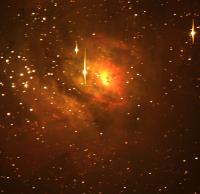A magazine where the digital world meets the real world.
On the web
- Home
- Browse by date
- Browse by topic
- Enter the maze
- Follow our blog
- Follow us on Twitter
- Resources for teachers
- Subscribe
In print
What is cs4fn?
- About us
- Contact us
- Partners
- Privacy and cookies
- Copyright and contributions
- Links to other fun sites
- Complete our questionnaire, give us feedback
Search:
Second star to the right, and emailed by morning

Robots can come in all sorts of different shapes and sizes, but there is one robot that is really a 'star player'. The team in the Department of Cybernetics at the University of Bradford have come up with a unique sort of robot, a robot that controls a giant telescope observatory in the Canary Islands. The Bradford Robotic Telescope installation is part of the Observatorio del Teide site perched on top of the northern part of the volcano caldera in Tenerife, and you can take control of it. It's free to use. You just need to register. You can ask the robot telescope to take pictures of any part of the sky you want and have it email the picture to you. So whether it's pictures for a school project or just because you are wondering what the surface of the moon is looking like today, the telescope is there for you to use.
Smart scope

Like many robots the telescope has intelligence. It has the sense to decide if it is safe to open the dome and expose the telescope to the elements. The robot has sensors that can detect the weather outside, the wind speed, the temperature and so on, and if the weather is too bad, which it can be on top of an exposed volcano, it doesn't open the door. Assuming the weather is fine, the sky views are spectacular. The isolated location of the telescope cuts out 'light pollution' from street lamps, and the clear atmosphere makes the images much sharper. The telescope is also clever in the way it works through the long list of images that people have requested. Rather that simply swinging the telescope around randomly, the robot looks through the requests and works out the most efficient sequence to take them in. It then sends the images in emails to eager astronomers the world over.
So if you fancy trying your hand at astronomy from the comfort of your PC, why not ask the telescope for help.


